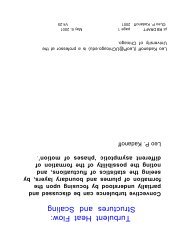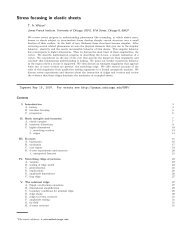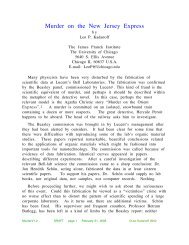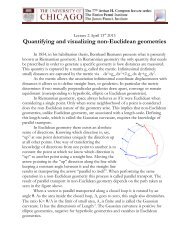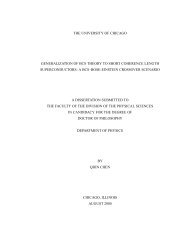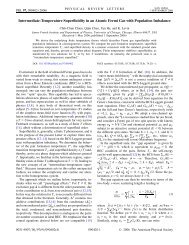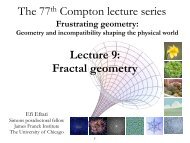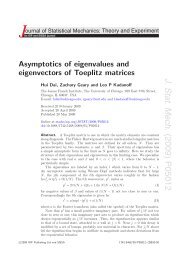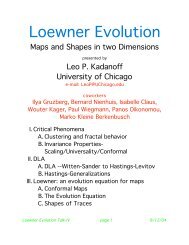Summary of Research Accomplishments
Summary of Research Accomplishments
Summary of Research Accomplishments
You also want an ePaper? Increase the reach of your titles
YUMPU automatically turns print PDFs into web optimized ePapers that Google loves.
<strong>Research</strong> Interests Qijin Chen Page 2 <strong>of</strong> 3<br />
Current <strong>Research</strong> Interests<br />
I have very broad research interests. For example, I have made significant scientific contributions<br />
in experimental condensed matter physics, and also had one year’s training in superstring theory.<br />
My primary focus is on the physics <strong>of</strong> superfluidity and related phenomena in ultracold atomic<br />
Fermi gases, while I am also interested in other areas outlined below.<br />
1. Ultracold atomic Fermi gases, optical lattices and quantum simulation<br />
Superfluidity in ultracold atomic Fermi gases is one <strong>of</strong> the most exciting research areas in condensed<br />
matter and atomic physics in recent years. Via Feshbach resonances, one can tune the<br />
attractive interaction between fermionic atoms from very weak to very strong. This makes it possible<br />
to observe Bose-Einstein condensation (BEC) in quantum degenerate Fermi gases directly<br />
over the entire range <strong>of</strong> the BCS-BEC crossover. Furthermore, this has created a strong hope that<br />
study <strong>of</strong> these systems may help us understand high Tc superconductivity. Another exciting tunable<br />
parameter in atomic Fermi gases is the population imbalance between the two spin species. The<br />
associated physics has turned out to be very rich. Added recently to this richness is the tunable<br />
mass ratio between the pairing atoms. Finally, optical lattices <strong>of</strong> atomic traps may be used to simulate<br />
typical as well as exotic condensed matter systems, e.g., the Hubbard model, so that study <strong>of</strong><br />
such simulated systems may provide a solution to unsolved problems in condensed matter physics.<br />
Even further, one can engineer many new systems to study exotic quantum phenomena.<br />
Over the past a few years, this field has seen very rapid progress. In 2003, the Jin group<br />
at JILA and the Grimm group at Universität Innsbruck, Austria made a big breakthrough and<br />
achieved molecular condensation in trapped atomic Fermi gases <strong>of</strong> 40 K and 6 Li, respectively. In<br />
2004, condensation <strong>of</strong> Cooper pairs was observed in 40 K by the Jin group and in 6 Li by the Grimm<br />
group and the Ketterle group at MIT. Evidence <strong>of</strong> superfluid phase transition were observed in<br />
thermodynamic behavior <strong>of</strong> 6 Li by the Thomas group at Duke and the Levin group in Chicago. In<br />
2005, the Ketterle group observed vortex lattices in 6 Li, which is the most definitive signature <strong>of</strong><br />
superfluidity. Population imbalance effects have become one <strong>of</strong> the hottest subjects since 2006, led<br />
by the MIT group and the Hulet group at Rice University. Since then, there has been a bloom in<br />
the study <strong>of</strong> optical lattices. Recently, synthetic gauge field and orbital effects in cold atoms have<br />
become new hot topics.<br />
A number <strong>of</strong> theorists have been working in the area <strong>of</strong> Fermi gases. However, their work has<br />
mostly been based on either the mean-field BCS-Leggett theory at zero temperature or the finite<br />
temperature Noziéres–Schmitt-Rink approach at Tc. The latter lacks self-consistency and cannot<br />
possibly predict a pseudogap. Other theoretical work has been based on the Bose liquid theory,<br />
and lacks proper treatment <strong>of</strong> the important fermionic pairing interaction.<br />
Our pairing fluctuation theory, originally developed for the pseudogap physics in high Tc superconductivity,<br />
has turned out very successful when applied to ultracold atomic Fermi gases. My<br />
current research includes fixing a couple <strong>of</strong> minor defects <strong>of</strong> this theory and apply it to more experiments<br />
or make more predictions. Of course, my research does not necessarily have to do with<br />
this theory. For example, one may proceed with completely different theories with optical lattices,<br />
synthetic gauge fields, etc.



